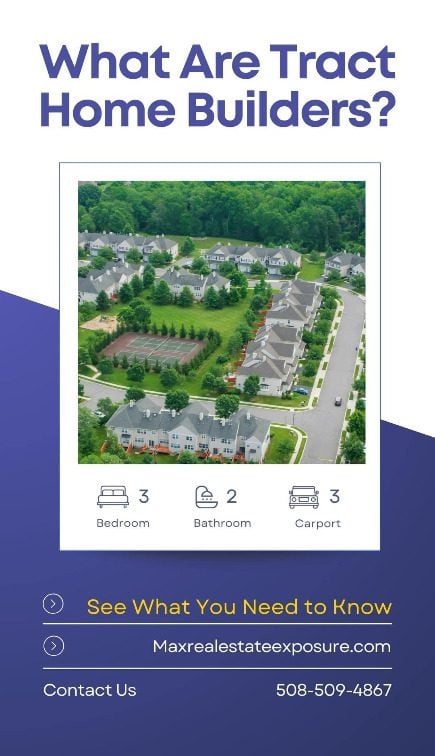 Have you ever seen a grouping of identical little dwellings? Chances are, it was a subdivision built with mass-produced homes.
Have you ever seen a grouping of identical little dwellings? Chances are, it was a subdivision built with mass-produced homes.
A tract home is a popular and affordable housing option. Connected to other homes on a shared plot of land, these properties are constructed efficiently, resulting in lower prices.
While they may lack customization options, tract homes offer buyers the chance to buy a low-cost new home.
We will examine tract housing, explore its advantages and disadvantages, discuss the construction process, compare them with other property types, and offer tips on buying the right tract home.
Comprehensive Analysis of Tract Homes
We will thoroughly examine tract houses, encompassing their meaning, origin, advantages, and disadvantages.
What is a Tract Home?
The comprehension and interpretation of tract houses are generally uncomplicated.
A tract home is a dwelling constructed in neighborhoods where multiple equivalent buildings are established on land split into smaller parcels.
These properties are typically carbon copies of one another with minimal differences in architectural details. Many refer to tract housing as production homes or “cookie cutters” because of the lack of customization and unique designs.
The lot size is usually tiny, allowing tract builders to construct numerous houses on the tract of land.
Tract homes are sometimes constructed as prefab housing, making it even more efficient for builders to build many houses.
The price per square foot of a tract house is often less than other housing choices as it is a cheaper form of construction.
Local zoning allows tract builders to put more houses in a neighborhood due to smaller lot sizes with reduced frontage and side property line setbacks.
Tract housing developments are primarily found in suburban areas.
The Origins of Tract Homes in Levittown, New York
The idea of mass-produced homes came after Levittown was established in New York following the Great Depression. It is known as the first starter home community.
The interest in inexpensive housing surged, causing developers to utilize productive construction procedures to fulfill the demands of the public. This lodging option became increasingly desirable because of its cost-effective preparation and effective space utilization.
Advantages of Tract Homes
One of the primary advantages of tract housing is its affordability. These homes are cheaper to construct than other housing types due to the efficient use of space and bulk purchase of materials. They are readily available in many regions, making them ideal for those who need to move quickly.
Tract developments are often located in safe neighborhoods with low crime rates. Additionally, minor home improvements are typically allowed, allowing homeowners to personalize their living space to some extent.
Disadvantages of Tract Homes
Despite their affordability, tract homes have certain drawbacks. They lack originality and customization options, as they are usually similar or identical in design. This can limit creativity and individuality for homeowners who prefer unique architectural styles.
Another disadvantage is the slower appreciation of the resale value, making them less favorable for short-term sellers looking to make a significant profit.
What is a Tract Home Builder?
 A tract home builder is a company or individual that constructs tract housing. A tract builder typically builds on a large scale and follows a standardized design, layout, and floor plan.
A tract home builder is a company or individual that constructs tract housing. A tract builder typically builds on a large scale and follows a standardized design, layout, and floor plan.
The main goal of a tract home builder is to efficiently and cost-effectively produce a large number of homes that are similar in style and size.
Tract home builders often purchase a large plot of land and subdivide it into multiple lots. They build the homes with a pre-determined schedule and workflow. This approach allows them to streamline the new construction process and maximize efficiency.
Tract builders allow buyers to purchase new construction with a smaller budget. They create a community of affordable housing.
By utilizing standardized designs and materials, costs are reduced. A tract builder will usually have established relationships with suppliers and subcontractors.
By building many properties, they can negotiate for better pricing with vendors. They are the opposite of a custom home builder.
From experience as a Realtor, asking a builder questions before committing is vital.
Understanding the Construction Process of Tract Housing
Efficient methods, repetitive nature, and limited customization options characterize the construction process of tract homes.
Let’s delve into the details of how these properties are built.
Efficient Construction Methods
Tract housing is known for its efficient construction methods, which help keep costs down. Builders optimize the use of space and materials, ensuring a streamlined process. This efficiency translates into more affordable homes for buyers.
Repetitive Nature of Construction
Tract homes are built repetitively, following a standardized template. Once the initial house is planned and constructed, the process is replicated for the other properties in the development. This repetition ensures consistency in design and allows for a faster construction timeline.
Similarities and Lack of Customization
One characteristic of tract homes is their similarities or near-identical designs. These homes often comprise a more considerable development following a predefined blueprint.
As a result, customization options for individual buyers are limited. While there may be a few choices for finishes or upgrades, significant structural alterations are typically impossible.
Buyers of tract homes should be prepared for a standardized aesthetic and layout. While this lack of customization may seem limiting to some, it also contributes to affordability and efficiency.
Comparing Tract Homes with Other Types of Housing
Regarding housing options, tract homes have distinct characteristics that set them apart from other housing types, such as custom, prefabricated, and spec houses.
When comparing them with these alternatives, let’s explore the key differences and considerations.
Tract Homes vs. Custom Homes
Tract homes and custom homes represent two different ends of the housing spectrum. While tract houses are designed and built on a large scale with a uniform layout, custom housing is unique, tailor-made residences that often involve individual architects, builders, and personalized design choices.
Custom properties offer higher levels of customization and flexibility regarding floor plans, materials, and features.Click To TweetTract Homes vs. Spec Houses
Spec homes, or speculative homes, are properties constructed by builders or investors without a specific buyer. In contrast, tract housing is built to be sold to individual buyers. The critical difference lies in the target audience and purpose of construction.
Tract homes are typically more affordable due to economies of scale and standardized construction processes, whereas spec housing often caters to higher-end buyers seeking unique features or customizations.
For example, builders often construct McMansions to satisfy the upper end of the real estate market. Some say these are more significant tract homes with additional upgrades and features. Hence the comparison to McDonald’s, a mass-production fast food restaurant. They are nothing more than large tract homes.
Tract Homes vs. Prefabricated Homes
Prefabricated or prefab houses are constructed off-site in a factory and then transported to the owner’s land for final assembly. Tract homes, on the other hand, are built on-site using efficient construction methods.
While both options offer cost savings and faster construction timelines than traditional on-site buildings, prefabricated housing often provides more flexibility regarding design options and customization.
Buying a Tract Home
 Buying a tract house can be a straightforward process. From experience as a Realtor, here are valuable insights and tips to ensure a smooth transaction.
Buying a tract house can be a straightforward process. From experience as a Realtor, here are valuable insights and tips to ensure a smooth transaction.
How to Buy Tract Housing
When considering purchasing tract properties, it’s essential to follow these steps:
- Research: Begin by researching different tract home developments in your desired area. Look for reputable builders with a track record of quality construction.
- Visit Model Homes: Visit the models in the development you are interested in. Take your time to explore the layout, finishes, and available options.
- Review Financing Options: Determine your budget and explore different financing options. Get pre-approved for a mortgage to streamline the buying process.
- Understand the Contract: Carefully review the purchase contract and any warranty information the builder provides. Seek legal advice from a real estate attorney to ensure all terms are clear.
- Finalize the Purchase: Work closely with the builder or their designated sales agent to finalize the purchase. Ensure that all necessary paperwork is completed accurately.
Finding and Working with a Real Estate Agent
While tract home purchases often involve working directly with the builder, some buyers may prefer the assistance of a real estate agent.
Here are some tips:
- Referrals: Seek recommendations from friends, family, or colleagues who have recently bought or sold a home.
- Experience: Choose a buyer’s agent with expertise in new construction and tract house purchases.
- Communication: Establish clear contact with your agent regarding your preferences, budget, and desired location for your tract house.
- Negotiation: Your agent can help negotiate with the builder on your behalf, ensuring you secure the best possible deal.
Tips for Choosing the Right Tract Home
Consider the following factors when choosing the ideal tract house for your needs:
- Location: Assess the neighborhood and its proximity to schools, amenities, and transportation.
- Size and Layout: Consider your family’s needs and lifestyle. Ensure the home’s layout aligns with your preferences.
- Upgrades and Customization: Check if the builder offers customization options or upgrade packages that suit your style.
- Resale Value: Evaluate the potential resale value of the home, as well as the overall desirability of the neighborhood.
- Homeowner’s Association (HOA): Research the rules and regulations of the HOA, if applicable, to understand any additional responsibilities or restrictions.
By following these guidelines, you can confidently navigate the process of purchasing tract housing and find the perfect home that meets your requirements.
Pros and Cons of Owning a Tract Home
When considering purchasing a tract home, weighing the pros and cons is essential. While they offer certain benefits, they also come with some drawbacks. Understanding the potential resale value and investment prospects is crucial for long-term financial planning.
Benefits of Owning a Tract Home
Owning a tract home can offer several advantages:
- Affordability: Tract homes are more cost-effective than other housing options due to their efficient construction methods and bulk material purchases. Expect the cost of building a house to be lower.
- Safe Neighborhood: Tract developments are often located in areas with low crime rates, providing homeowners with a sense of security for their families. There is usually a strong sense of community among residents.
- Availability and Quick Acquisition: These properties are readily available in many regions and can be acquired quickly, ideal for individuals who need to hurry.
- Permitted Improvements: Tract homeowners generally have the flexibility to make minor home improvements, allowing for personalization within certain limits.
Drawbacks of Owning a Tract Home
However, there are some disadvantages to consider when owning a tract home:
- Limited privacy: Since they are built on small lots close to one other, it is expected to be on top of your neighbor. Your view will typically be your neighbor’s house and yard.
- Lack of Customization: They are usually similar or identical in home design, limiting the homeowner’s ability to customize or add unique features to their property.
- Reduced Originality: Due to their repetitive construction process, a tract home lacks the originality and individuality of custom or unique properties.
- Slow Resale Value Growth: The resale value may not increase rapidly, which can disadvantage homeowners looking for short-term investment opportunities.
Resale Value and Investment Potential of Tract Housing
While tract homes may not experience rapid appreciation in value, they can still be a viable long-term investment option. Factors such as location, market conditions, and overall demand for housing play significant roles in determining a tract home’s resale value and investment potential.
It’s important for prospective buyers to thoroughly research the specific tract development and its past resale performance and consider future growth and development plans for the surrounding area.
Assessing these factors can provide a clearer understanding of the investment potential and help make an informed decision when considering a tract home purchase.
If you need any help, please get in touch with me.
About the Author: The above Real Estate information on what a tract home is was provided by Bill Gassett, a Nationally recognized leader in his field. Bill has expertise in mortgages, financing, moving, home improvement, and general real estate.
Learn more about Bill Gassett and the publications he has been featured in. Bill can be reached via email at billgassett@remaxexec.com or by phone at 508-625-0191. Bill has helped people move in and out of Metrowest towns for the last 37+ years.
Are you thinking of selling your home? I am passionate about real estate and love sharing my marketing expertise!
I service Real Estate Sales in the following Metrowest MA towns: Ashland, Bellingham, Douglas, Framingham, Franklin, Grafton, Holliston, Hopkinton, Hopedale, Medway, Mendon, Milford, Millbury, Millville, Natick, Northborough, Northbridge, Shrewsbury, Southborough, Sutton, Wayland, Westborough, Whitinsville, Worcester, Upton, and Uxbridge MA.

